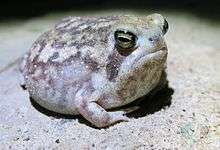Breviceps adspersus
Breviceps adspersus, also known as common rain frog, bushveld rain frog, and many other vernacular names, is a species of frog in the family Brevicipitidae.[2] It is found in Southern Africa, in Angola, Namibia, Botswana, Zambia, Zimbabwe, South Africa, Eswatini, and Mozambique.[1][2]
| Common rain frog | |
|---|---|
 | |
| Breviceps adspersus, Limpopo, South Africa. | |
| Scientific classification | |
| Kingdom: | Animalia |
| Phylum: | Chordata |
| Class: | Amphibia |
| Order: | Anura |
| Family: | Brevicipitidae |
| Genus: | Breviceps |
| Species: | B. adspersus |
| Binomial name | |
| Breviceps adspersus Peters, 1882 | |
 | |
| Synonyms[2] | |
| |
Description
The common rain frog lives underground, only emerging to feed and mate after a rain, usually at nighttime. Its body is stout and globular, with a grumpy face. The color of this species is either day or night brown, with rows of lighter tan orange patches, with blue borders. It also has the short, stout limbs typical of most burrowing frogs and toads. However, its back feet are like spades and are able to dig up to 20 inches below underground. If attacked, the frog inflates and lodges itself firmly inside of the burrow. These beautiful little creatures can be caught gently and easily by hand in the rain. Once on your palm, they inflate, and if tilted slightly, they spread out their fore- and hindlegs to keep from sliding. They also walk, rather than hop, quite quickly. The females are also much larger than males. Since the male cannot grip the female during mating because of the size difference, the female secretes a kind of glue from her back to keep the mating pair together. The stuck-together pair burrow backwards into the soil until they reach a moist spot. Once a suitable spot is reached, the female lays her eggs. The eggs hatch directly into froglets instead of tadpoles. They are 1½ to 2¼ inches long (3 to 6 centimeters).[3][4]
The common rain frog inhabits temperate forests and open grasslands of southeast Africa. They are a terrestrial species. These frogs only breed in the rainy season. The population of this species is stable, and listed as "locally common".[3]
Diet
The common rain frog eats insects and termites. Babies often eat caterpillars. First, the adult smacks the bug's head, and this is called dapping. Then they locate the insect. After locating, they use their sticky tongues to lap up the insect.
References
- IUCN SSC Amphibian Specialist Group (2013). "Breviceps adspersus". IUCN Red List of Threatened Species. 2013: e.T57712A3061969. Retrieved 30 November 2013.
- Frost, Darrel R. (2020). "Breviceps adspersus Peters, 1882". Amphibian Species of the World: an Online Reference. Version 6.1. American Museum of Natural History. doi:10.5531/db.vz.0001. Retrieved 29 June 2020.
- Burnie, David; Wilson, Don E., eds. (2005-09-19). "Amphibians". Animal: The Definitive Visual Guide to the World's Wildlife. New York, New York: Dorling Kindersley, Smithsonian Institution. pp. 456. ISBN 0-7566-1634-4.
- "Narrow-Mouthed Frogs: Microhylidae - Behavior And Reproduction". animals.jrank.org. Retrieved 2017-08-01.
| Wikispecies has information related to Breviceps adspersus |
